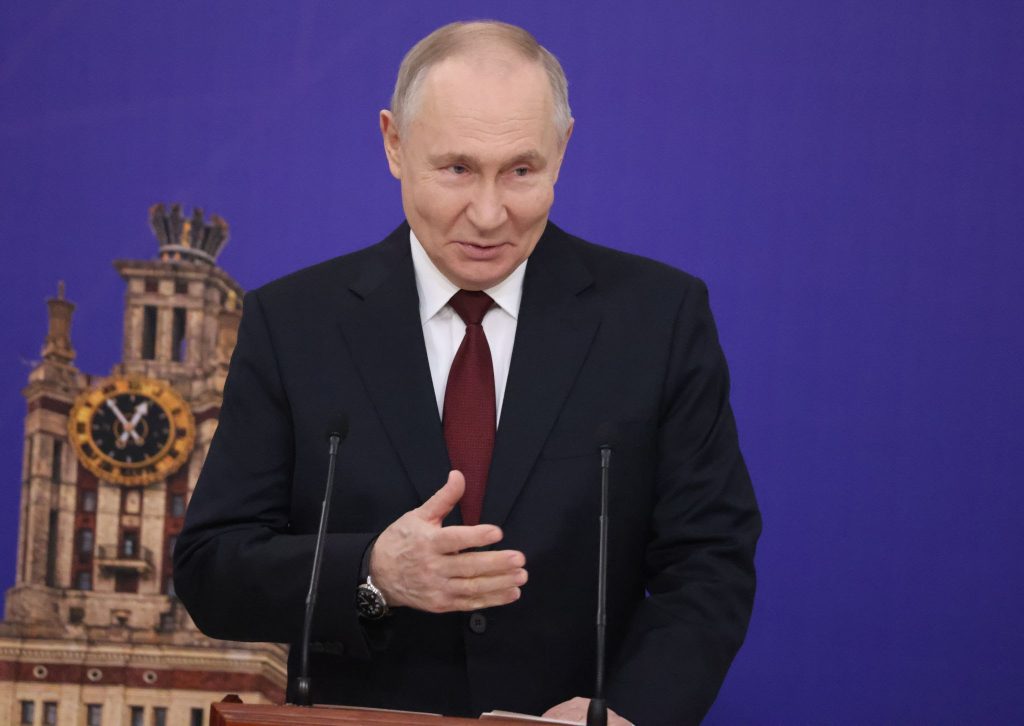
MOSCOW, RUSSIA - JANUARY 24 (RUSSIA OUT) Russian President Vladimir Putin speaks during the awarding ceremony at the Moscow State University, on January 24, 2025, in Moscow, Russia. Putin visited the oldest university in Russia, marking the Russian Students Day. (Photo by Contributor/Getty Images)
If you want peace in Ukraine, pressure Russia. If you want war, don’t. The Trump people only make concessions. Which is exactly what the Kremlin expected. The US through its astounding weakness is making the war longer and bloodier than it has to be.
To the 307 Ukrainian prisoners of war released this week and returned to their facilities – welcome home!
In this week’s renamed edition of The Big Five, I focus on two key issues. First, the unleashing of Putin’s most brutal instincts as a result of Trump walking away from the peace talks, and the war, earlier this week.
Second, I examine the ground war, particularly Russia’s eastern offensive and the potential for a stepped up Russian offensive in Kharkiv.
As always, I conclude with my top five war and national security reads from the week.
In the past 48 hours, we have seen Putin conform to his very worst instincts and unleash large-scale missile and drone attacks on Ukrainian cities.
On the evening of 23 May, Putin unleashed over two hundred and fifty drones and missiles against Ukrainian cities, including Kyiv, Kharkiv and Odesa. As the chart below from the Ukrainian Air Force shows, nearly 250 drones and six missiles were used in the attacks.
On the evening of 24 May, Putin’s forces continued their attacks against civilians in Ukraine’s major cities. At least eight people are known to have been killed by the Russian attacks.
This time, the Russian used a larger proportion of cruise missiles than on the previous evening. According to at least one account (AMK Mapping) that has tracked these attacks in the past couple of nights, the Russians used over 60 missiles in the attacks on the evening of 24 May, which included:
An initial map of the cruise missile tracks is shown below, demonstrating the variety of launch platforms and locations employed by the Russians.
The daily average number of Shahed attacks against Ukraine (see below) had trended around 125 per day in February and March, before dropping back to a daily average of around 80 attacks per day in April.
Clearly this was just an operational dip in tempo, possibly related to peace negotiations, before a resumption of the storm in May.
The strikes on Ukraine by Russia indicate that Putin no longer fears any kind of retribution for his actions from this U.S. administration.
Putin, who believes he can win this war, has eschewed every attempt to bring about a ceasefire or conduct meaningful negotiations about war termination.
As two recent U.S. intelligence assessments have described, Putin believes he can win this war and is doing everything he can do so. The DIA threat assessment released this week notes that:
Russian President Vladimir Putin regards the war in Ukraine as an existential struggle against the West that will determine Russia’s place in the world, Putin’s hold on power, and his historical legacy.
Putin remains confident in Russia’s ultimate victory in Ukraine and is prepared to use military force at least through 2025.
The U.S. Intelligence Community annual threat assessment, released in March this year, described how:
President Vladimir Putin appears resolved and prepared to pay a very high price to prevail in what he sees as a defining time in Russia’s strategic competition with the United States, world history, and his personal legacy. For Russia, positive battlefield trends allow for some strategic patience
And supposedly the U.S. president agrees with him.
Trump apparently told European leaders in the wake of his phone call with Putin this week that the Russian leader “isn’t ready to end the Ukraine war because he thinks he is winning.” Trump has now set aside any pretentions of being a key player in peace negotiations.
For Putin and Russia, this is a wonderful development in its relationship with the Trump administration.
For Putin, this means that as long as he does not escalate the war beyond Ukraine’s borders, Putin now has a free hand to do as he wishes in Ukraine.
His massive attacks on Ukraine over the weekend are indicative of Putin’s mindset now: “Trump has walked away so anything goes.”
Missile attacks like those in the past 48 hours, and other large scale drone and missile attacks by the Russians in April, March and February this year, are a way that Putin demonstrates his resolve, and his belief that Russia cannot lose this war because of its destiny as a great power.
It is also a way for him to telegraph to the U.S. administration that any assistance America provides to Ukraine is wasted.
So far, that appears to be working – the Trump administration has not asked Congress to appropriate any additional funds for aid to Ukraine.
There is little prospect of that occuring either. But U.S training and intelligence assistance is continuing, as is the delivery of equipment and munitions promised during the Biden administration.
As long as that continues, combined with European aid and increasing Ukrainian defence production, Ukraine will survive Russia’s 2025 offensive.
The real question is this: what happens when, as is likely, the 2025 Russian ground offensive proves to be as limited in return as its 2022, 2023 and 2024 offensives?
Putin hardly possesses a strong set of cards however (sorry, I could not resist that metaphor). Even if he was to agree to some form of ceasefire now, Putin has very little to show from his three-plus years of war.
He would face some very uncomfortable questions about the returns on investment of nearly one million casualties and the majority of Russia’s modern army weapons.
He has actually painted himself into a corner (not the actions of a master strategist) and probably only sees one way out of the war – winning it.
Which is very, very unlikely as long as Ukraine defends itself.
The massive number of casualties that Russia has suffered (the one million mark will be passed some time in June), the declining stocks of military vehicles and the small territorial gains he has made in the past year are not indicative of his military operations achieving Putin’s maximalist goals for the war.
This is why the ongoing ground offensive, which is bound to increase in tempo in the coming weeks, is so important to Putin. He really, really needs some kind of decisive outcome from the 2025 Russian offensive.
Over the past few weeks, I have been examining some of the key elements of the ongoing Russian offensive in the east and north east of Ukraine. You can read some of these here, here and here.
In the past few weeks, there have been stories about the Russians concentrating forces for an offensive on Kharkiv. This isn’t the first time the Russians have tried this during their full-scale invasion since 2022.
The initial Russian thrusts into Ukraine included a significant advance into Kharkiv which saw the Russian’s seize large amounts of territory in the oblast.
While Ukraine managed to liberate some of the captured territory, the Russians still occupied about 40% of Kharkiv at the end of August 2022 (see Map 1 below).
But then came the surpirse Ukrainian offensive of September 2022. This pushed the Russians out of Kharkiv entirely (see Maps 2 and 3 below).
The Russians were kept out of Kharkiv until May 2024. Then the Russians began another offensive there.
In May 2024, the Russians commenced operations in the north of Kharkiv. This included cross-border shelling and the infiltration of troops across the border.
This initially achieved tactical surprise in the region, the Russians were able to advance several kilometres into Kharkiv.
In the middle of 2024, the Russians also commenced their advance west from occupied Luhansk towards the Oskil River. While the Oskil may have been a tactical objective, the overal operational objective of this advance from Luhansk was probably the critical M-03 Highway that links Kharkiv and important cities like Izium and Kramatorsk. That objective is likely to be one of the desired outcomes of Russian ground operations in 2025.
By late October, the Russians had created a salient in eastern Kharkiv with Russian forces closing up on the Oskil River. By December, the Russians had reached the Oskil on two separate axes of advance.
And as of this week, the Russians continue to slowly advance in eastern Kharkiv. Overall, since May 2024, the Russians have achieved advances of about 5-7 kilometres into northern Kharkiv, and of about 17 kilometres into eastern Kharkiv.
Assessment. The Russian forces that are concentrating in Belgorod actually have the advantage of interior lines. They might strike south into Kharkiv but might also strike west into Sumy. There is some potential for Russia’s current posturing about a Kharkiv offensive to be a deception plan for an advance by Russian troops on a different objective entirely.
We might expect too that the Russians undertake a slightly increased tempo of operations in southern Ukraine as a way to ensure Ukraine cannot redeploy forces from that area to assist in defending eastern Ukraine.
The eastern region of Kharkiv probably offers greater potential returns than an increased rate of effort and allocation of resources to the ongoing offensive in northern Kharkiv.
However, if Russia was able to get back into artillery range of Kharkiv city, that would be a major political and military issues for Ukraine.
While Russia demonstrated significant gains in their 2022 offensive into Kharkiv, the battlefield environment was totally different then, as was the capacity and experience of the Ukrainians who were defending their homeland. It was an entirely different war, and 2022 cannot be used as indicative of the kinds of gains that Russia might make in any 2025 Kharkiv offensive.
The 2024-2025 Russian advances into Kharkiv in the north and east are probably more indicative of what is to come if the Russians do launch a larger series of operations in Kharkiv.
The experience of Ukrainian defenders now is much greater, and while both sides have a far larger drone capability now, the Russians are yet to demonstrate the ability for large gains in territory over a short period of time.
Adding another 50 thousand troops to a Kharkiv offensive is unlikely to change this.
Kharkiv is also unlikely to be the main effort for the Russians.
As I discussed in my analysis of ground operations last week, Russian operations further to the south around Pokrovsk are very likely to remain the Russian main effort on the ground.
The potential for Russian forces to capture an even larger proportion of Donetsk is likely to be a higher priority to Putin than more of Kharkiv (at least at present – eventually he wants everything).
As the result of a step up of Russian operations in Kharkiv and on its main effort in eastern Ukraine, It is likely that the Russians will suffer even greater average daily casualties in the coming months compared to the previous years.
Their average casualty rate has been increasing each year, as shown by the graph below. I expect to see this confirmed by an uptick in average casualties from June onwards.
I see almost no prospect for a Russian offensive in Kharkiv delivering any decisive battlefield outcomes for the Russians.
Even on Russia’s main effort around Pokrovsk, they lack the speed to be able to break the Ukrainian operational defences.
Their declining force quality, the lack of any offensive concept that can deliver operational level breakthroughs, Ukraine’s strikes on Russian munitions depots and its increasingly effective Drone Wall all offer the prospect of more Russians being thrown into the meatgrinder around Kharkiv in the coming months for minimal gains in territory.
That is the most likely outcome of the coming months. But, as a recent RUSI report notes, there is also a possible worst case outcome of the 2025 Russian offensive as well:
There is a darker possible future, in which the summer offensive overpowers Ukrainian defences to take key towns in Donbas, after which Russia pivots to attacking Kharkiv in the autumn, while once again switching its deep strike campaign to degrade Ukrainian power generation and distribution ahead of the winter.
Under such circumstances, the Russians hope that they can steadily convince Europe to pressure Ukraine to sue for peace, even on unacceptable terms.
It is the belief that this trajectory is possible that is keeping the Kremlin prepared to plough on, despite the chronic underperformance of its arms. Ukraine and its partners must strip the Kremlin of its illusions.
We can never discount these worst case scenarios. Imagining such potential futures is a crucal part of military planning in general, and Ukraine’s military planning in particular. Most military planning processes develop ‘enemy most likely’ and ‘enemy most dangerous’ courses of action to test their plans.
However, while Ukraine still has challenges with its personnel and reinforcements for frontline units, nothing in the current correlation of Ukrainian and Russian forces indicates that such a catastrophic outcome is in the offing.
The Russians, while able to continuously take small parcels of land, do not appear to have the new operating concepts or large quantity of quality leaders and units to drastically improve their military effectiveness.
They can advance, but not at tempo that would overwhelm Ukrainian operational plans.
Overall, we appear to have arrived at a decisive moment in the Ukraine War.
Back in February this year, in an article I called “Not Yet Our Darkest Hour”, I reviewed several potential outcomes of Trump’s interventions into the war in Ukraine. One potential scenario I explored was as follows:
5. Trump walks away. This would see an exasperated Trump, impatient at not being able to get a deal because, you know, war is complicated and war termination is even harder, disengage America from the peace process and in essence say “Europe, Ukraine and Russia, sort it out among yourselves”.
Implications: It is very unlikely that negotiations would continue under this scenario. Putin only wants to deal with those he sees as equals, which is Trump. And, of course, Xi, which leads me to the final scenario.
It now appears that this is what we are seeing.
Putin has been unleashed by Trump’s dithering, inability to conceptualise the realities of war and negotiating peace agreements, and lack of empathy for the Ukrainian people.
American aid, which is likely to continue for the duration of 2025 because of Biden’s commitments, will potentially trend down in 2026.
Europe’s moment has come, and it has no choice but to step up its aid to Ukraine now. It can either defend against Russia in Ukraine now, or do so in Finland, the Baltics and Poland in the future.
And finally, as I noted in my piece at the start of this week, Trump’s call with Putin has clarified in the minds of Ukrainians where the American political leadership stands in its relationship with Ukraine.
How Ukraine conceives its foreign relationships, and integrates foreign support into its overall defensive strategy, will be very different henceforth.
Since my last edition of The Big Five, I have published two articles here: one on the implications of President Trump’s telephone conversation with the Russian president, and one on the the development of Ukraine’s Drone Wall and its implications.
I also published an article with the Lowy Institute’s The Interpreter. This time, I explored Ukrainian adaptation during the war, and how the Australian Defence Force was demonstrating little capacity to learn from the conflict. You can read that article at this link.
This week, I have included an article on that explores the co-evolutionary pathway of drones and EW in the Ukraine war.
There are two great pieces on the Pacific: one about regional responses to a Taiwan contingency and the second about China and Russia’s deeper collaboration on national security issues.
There is an article that explores myths that have arisen about the development and use of uncrewed systems on military operations, and an examination of the Russian 2025 ground offensive in Ukraine.
The adaptation battle between Russian and Ukrainian drones has been heavily reliant on another adpatation battle – electronic warfare (EW).
EW has seen a massive resurgence since the beginning of the war. While many of us used it in Iraq and Afghanistan to defeat insurgent IEDS, in recent years the focus on EW has been overtaken by cyber operations.
The drone war in Ukraine has seen a big come back for EW operations, which is a key theme in this article on how Ukraine is defeating Russian EW efforts. You can read the full article at this link.
I know I haven’t covered the Pacific theatre this week, but that doesn’t mean it is forgotten! In this excellent article from The Jamestown Foundation, the author explores developments in Russia-China collaboration in the wake of the recent Xi visit to Moscow, and the joint statements issued by Xi and Putin on several national security topics.
This relationship is central to the developing authoritarian learning and adaptation bloc. You can read the full piece here.
A second report focused on the Pacific theatre this week explores the prospects for coalition building in the event of direct Chinese aggression against Taiwan in the form of a blockade or invasion.
This new report from the Center for a New American Security explores how regional nations might respond to a Taiwan contingency, and what this means for American strategic responses. You can read the full report at this link.
This week, expert on drone technology and policy, Mike Horowitz, published an excellent article with War on the Rocks that explored some of the myths surrounding the development and employment of lethal uncrewed systems by the United States Department of Defence. It is a succint and clear summary of some of the misconceptions that have arisen around autonomy and uncrewed systems, and well worth a read. The full article is available here.
While the Russian offensive for 2025 has already commenced, it is very likely to increase in tempo and geographic scope in the coming months.
This is another excellent assessment of Ukraine’s key challenges for the coming months, and can be read here.




